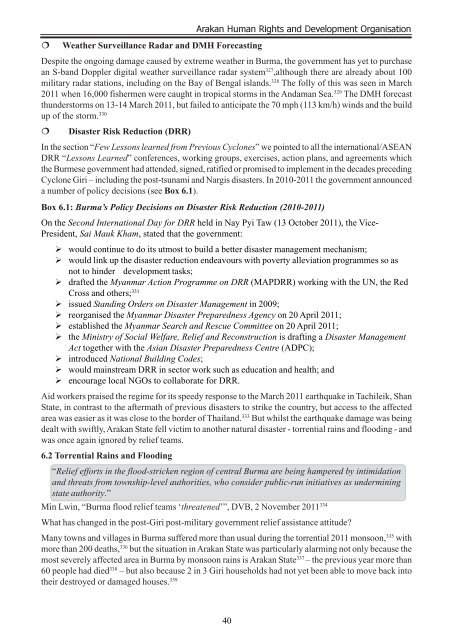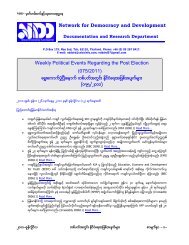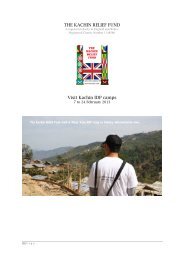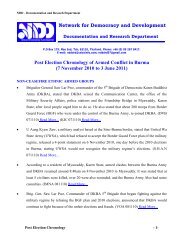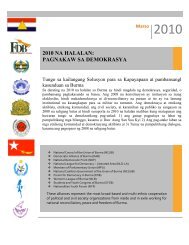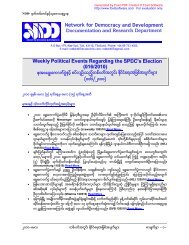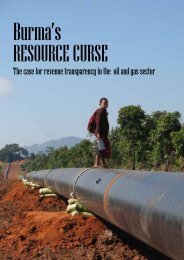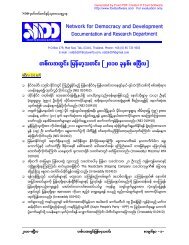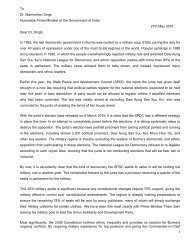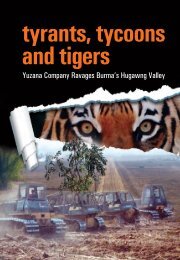Cyclone Giri - Two Years On - Burma Action Ireland
Cyclone Giri - Two Years On - Burma Action Ireland
Cyclone Giri - Two Years On - Burma Action Ireland
You also want an ePaper? Increase the reach of your titles
YUMPU automatically turns print PDFs into web optimized ePapers that Google loves.
Arakan Human Rights and Development Organisation<br />
Weather Surveillance Radar and DMH Forecasting<br />
Despite the ongoing damage caused by extreme weather in <strong>Burma</strong>, the government has yet to purchase<br />
an S-band Doppler digital weather surveillance radar system 327 ,although there are already about 100<br />
military radar stations, including on the Bay of Bengal islands. 328 The folly of this was seen in March<br />
2011 when 16,000 fishermen were caught in tropical storms in the Andaman Sea. 329 The DMH forecast<br />
thunderstorms on 13-14 March 2011, but failed to anticipate the 70 mph (113 km/h) winds and the build<br />
up of the storm. 330<br />
Disaster Risk Reduction (DRR)<br />
In the section “Few Lessons learned from Previous <strong>Cyclone</strong>s” we pointed to all the international/ASEAN<br />
DRR “Lessons Learned” conferences, working groups, exercises, action plans, and agreements which<br />
the Burmese government had attended, signed, ratified or promised to implement in the decades preceding<br />
<strong>Cyclone</strong> <strong>Giri</strong> – including the post-tsunami and Nargis disasters. In 2010-2011 the government announced<br />
a number of policy decisions (see Box 6.1).<br />
Box 6.1: <strong>Burma</strong>’s Policy Decisions on Disaster Risk Reduction (2010-2011)<br />
<strong>On</strong> the Second International Day for DRR held in Nay Pyi Taw (13 October 2011), the Vice-<br />
President, Sai Mauk Kham, stated that the government:<br />
would continue to do its utmost to build a better disaster management mechanism;<br />
would link up the disaster reduction endeavours with poverty alleviation programmes so as<br />
not to hinder development tasks;<br />
drafted the Myanmar <strong>Action</strong> Programme on DRR (MAPDRR) working with the UN, the Red<br />
Cross and others; 331<br />
issued Standing Orders on Disaster Management in 2009;<br />
reorganised the Myanmar Disaster Preparedness Agency on 20 April 2011;<br />
established the Myanmar Search and Rescue Committee on 20 April 2011;<br />
the Ministry of Social Welfare, Relief and Reconstruction is drafting a Disaster Management<br />
Act together with the Asian Disaster Preparedness Centre (ADPC);<br />
introduced National Building Codes;<br />
would mainstream DRR in sector work such as education and health; and<br />
encourage local NGOs to collaborate for DRR.<br />
Aid workers praised the regime for its speedy response to the March 2011 earthquake in Tachileik, Shan<br />
State, in contrast to the aftermath of previous disasters to strike the country, but access to the affected<br />
area was easier as it was close to the border of Thailand. 333 But whilst the earthquake damage was being<br />
dealt with swiftly, Arakan State fell victim to another natural disaster - torrential rains and flooding - and<br />
was once again ignored by relief teams.<br />
6.2 Torrential Rains and Flooding<br />
“Relief efforts in the flood-stricken region of central <strong>Burma</strong> are being hampered by intimidation<br />
and threats from township-level authorities, who consider public-run initiatives as undermining<br />
state authority.”<br />
Min Lwin, “<strong>Burma</strong> flood relief teams ‘threatened’”, DVB, 2 November 2011 334<br />
What has changed in the post-<strong>Giri</strong> post-military government relief assistance attitude<br />
Many towns and villages in <strong>Burma</strong> suffered more than usual during the torrential 2011 monsoon, 335 with<br />
more than 200 deaths, 336 but the situation in Arakan State was particularly alarming not only because the<br />
most severely affected area in <strong>Burma</strong> by monsoon rains is Arakan State 337 – the previous year more than<br />
60 people had died 338 – but also because 2 in 3 <strong>Giri</strong> households had not yet been able to move back into<br />
their destroyed or damaged houses. 339 40


